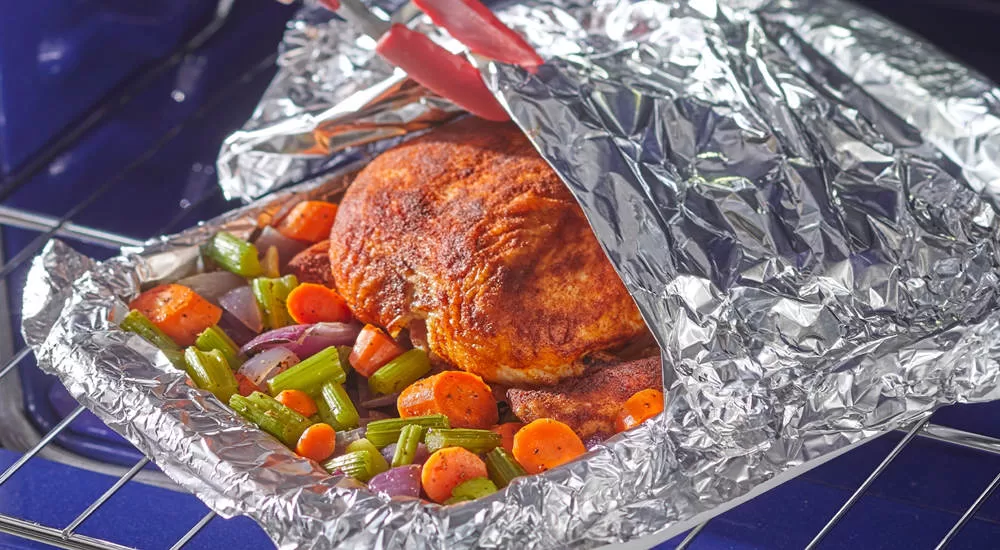Cooking with aluminum foil is a versatile and convenient method employed in kitchens worldwide. From wrapping food for baking or grilling to creating makeshift cooking vessels, aluminum foil serves a variety of purposes in the culinary realm. Let’s explore the ins and outs of cooking with aluminum foil, including its benefits, precautions, and creative applications.

Benefits of Cooking with Aluminum Foil:
- Heat Retention: Aluminum foil is an excellent conductor of heat, allowing it to evenly distribute heat around food items during cooking. This property makes it ideal for wrapping foods for baking or grilling, ensuring they cook evenly and retain moisture.
- Easy Cleanup: One of the greatest advantages of cooking with aluminium foil is its easy cleanup. Simply discard the foil after use, eliminating the need for scrubbing baking pans or grilling racks.
- Versatility: Aluminium foil can be molded into various shapes and forms, making it versatile for a wide range of cooking applications. Whether it’s wrapping vegetables for roasting, creating pouches for steaming fish, or lining baking pans, aluminum foil adapts to different culinary needs.
- Food Preservation: Aluminuim foil can help seal in moisture and flavor, preserving the freshness of food items during cooking and storage. It’s commonly used to wrap leftovers or pre-prepared meals for refrigeration or freezing.
- Grilling and Barbecuing: Aluminium foil is a staple accessory for outdoor cooking enthusiasts. It can be used to wrap meats, vegetables, and even fruits before placing them on the grill, preventing flare-ups and retaining juices.
Precautions When Cooking with Aluminum Foil:
- Acidic Foods: Avoid using aluminum foil with highly acidic or salty foods, such as tomatoes, citrus fruits, or vinegar-based marinades. The acidity can cause a reaction with the aluminum, leading to off-flavors and discoloration.
- Avoid Direct Contact with Flames: When grilling with aluminum foil, be cautious to prevent direct contact with open flames. Excessive heat can cause the foil to melt or catch fire, posing a safety hazard.
- Avoid Overlapping Layers: When wrapping foods in aluminium foil, avoid overlapping multiple layers of foil, as this can inhibit heat circulation and result in uneven cooking.
- Use Heavy-Duty Foil for Grilling: For grilling and barbecuing applications, opt for heavy-duty aluminum foil to withstand the high heat and prevent tearing or punctures.
- Proper Storage: Store aluminum foil in a cool, dry place away from moisture and humidity to prevent it from becoming damaged or corroded.
Creative Applications of Cooking with Aluminum Foil:
- Foil Packets: Create foil packets by wrapping seasoned meats, vegetables, and herbs in aluminum foil before cooking. This method locks in flavors and juices, resulting in tender and flavorful dishes.
- Fish En Papillote: Cook fish en papillote (in parchment) by wrapping fillets in aluminum foil along with herbs, vegetables, and seasonings. The sealed packets steam the fish, infusing it with flavor and keeping it moist.
- Campfire Cooking: Aluminum foil is a camping essential for cooking over an open flame. Use it to wrap potatoes for baking in the coals, make foil-wrapped sandwiches, or create foil packets filled with hearty ingredients for a delicious campfire meal.
- Grilled Desserts: Get creative with grilled desserts by wrapping fruits like peaches, bananas, or pineapple in aluminum foil with a sprinkle of sugar and cinnamon. Grill until tender and caramelized for a simple and satisfying sweet treat.
Conclusion:
Cooking with aluminum foil offers numerous benefits, including heat retention, easy cleanup, and versatility. By following precautions and exploring creative applications, aluminium foil can elevate your culinary endeavors, whether you’re baking, grilling, or cooking outdoors. With its convenience and adaptability, aluminum foil remains a staple tool in kitchens around the world, facilitating delicious and flavorful meals with minimal effort.